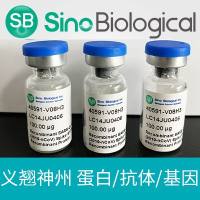This chapter describes a rapid and efficient approach for the solid-phase synthesis of N -linked glycopeptides that utilizes on-resin glycosylamine coupling to produce N -linked glycosylation sites. In this method, the full-length nonglycosylated peptide is first synthesized on a solid-phase support using standard Fmoc chemistry. The glycosylation site is then introduced through an orthogonally protected 2-phenylisopropyl (PhiPr) aspartic acid (Asp) residue. After selective deprotection of the Asp residue, a high mannose type oligosaccharide glycosylamine is coupled on-resin to the free Asp side chain to form a N -glycosidic bond. Subsequent protecting group removal and peptide cleavage from the resin ultimately yields the desired glycopeptide. This strategy provides an effective route for conducting glycosylation reactions on a solid-phase support, simplifies the process of glycopeptide purification relative to solution-phase glycopeptide synthesis strategies, and enables the recovery of potentially valuable, un-reacted oligosaccharides. This approach has been applied to the solid-phase synthesis of the N -linked high mannose glycosylated form of peptide T (ASTTTNYT), a fragment of the HIV-1 envelope glycoprotein gp120.






